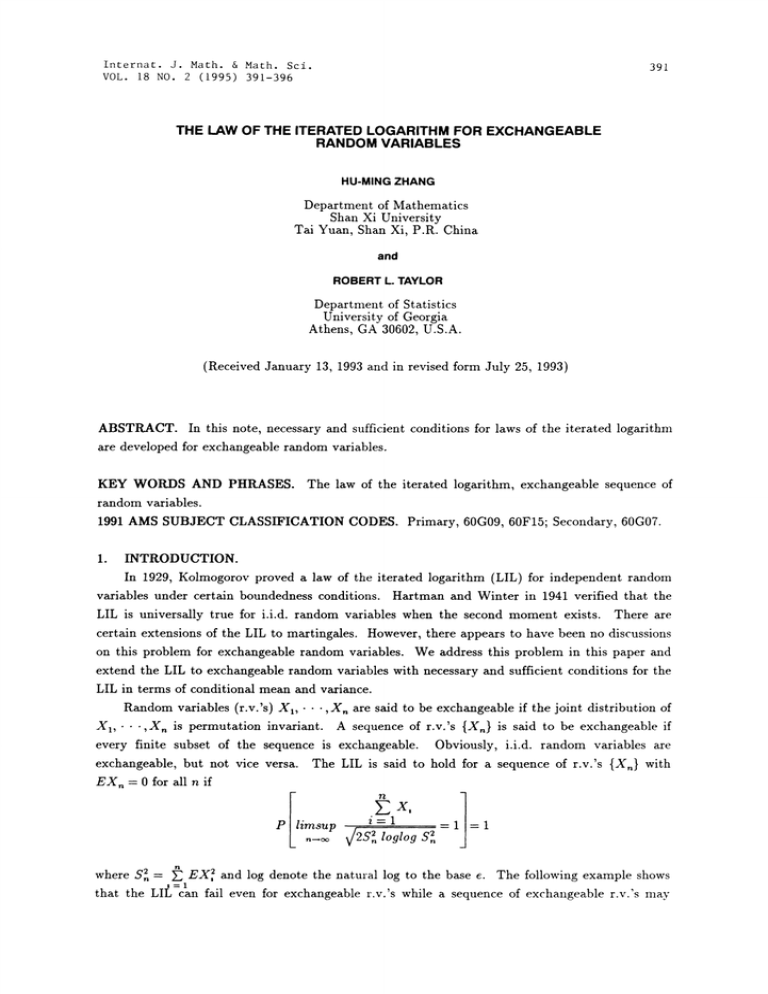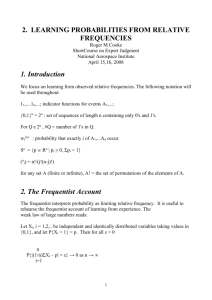Document 10442646
advertisement

Internat. J. Math. & Math. Sci.
VOL. 18 NO. 2 (1995) 39-396
391
THE LAW OF THE ITERATED LOGARITHM FOR EXCHANGEABLE
RANDOM VARIABLES
HU-MING ZHANG
Department of Mathematics
Shah Xi University
Tai
Yuan, Shan Xi, P.R. China
and
ROBERT L. TAYLOR
Department of Statistics
University of Georgia
Athens, GA 30602, U.S.A.
(Received January 13, 1993 and in revised form July 25, 1993)
ABSTRACT. In this note, necessary and sufficient conditions for laws of the iterated logarithm
are developed for exchangeable random variables.
KEY WORDS AND PHRASES. The law of the iterated logarithm, exchangeable sequence of
random variables.
1991 AMS SUBJECT CLASSIFICATION CODES. Primary, 60G09, 60F15; Secondary, 60G07.
1.
INTRODUCTION.
In 1929, Kolmogorov proved
a law of the iterated logarithm (LIL) for independent random
variables under certain boundedness conditions. Hartman and Winter in 1941 verified that the
LIL is universally true for i.i.d, random variables when the second moment exists. There are
certain extensions of the LIL to martingales. However, there appears to have been no discussions
on this problem for exchangeable random variables. We address this problem in this paper and
extend the LIL to exchangeable random variables with necessary and sufficient conditions for the
LIL in terms of conditional mean and variance.
Random variables (r.v.’s) X1," ,X, are said to be exchangeable if the joint distribution of
X1,-.-,X,, is permutation invariant. A sequence of r.v.’s {X,} is said to be exchangeable if
every finite subset of the sequence is exchangeable. Obviously, i.i.d, random variables are
exchangeable, but not vice versa. The LIL is said to hold for a sequence of r.v.’s {X,} with
EX, 0 for all n if
I
P imsup
n
=
where S
EX and log denote the natural log to the base e. The following example shows
that the LIL can fail even for exchangeable r.v.’s while a sequence of exchangeable r.v.’s may
392
H.-M. ZHANG AND R. L. TAYLOR
satisfy the LIL and not be independent r.v.’s.
EXAMPLE 1. Let {X,,n >_ 1} be a sequence of i.i.d, random variables such that EX 0
and
and let Y,, ZX,, n > 1, where the random variable Z is independent of the
sequence {X,,n >_ 1} with P(Z a)= P(Z b)=0.5. It is not difficult to see that {Y,} is a
sequence of exchangeable r.v.’s.
EX
Ifa=2andb=0, thenEY,,=0andEY=2foreveryn>l. We defineS2,=
U2, 2 loglog S. Clearly,
P limsup
in view of the fact that by
[4],
limsup
=0
=1 =0.hP lira
EY2jand
(1.1)
n
/2n Io9Io9 n
limsup
(1.2)
1, a.s.
2n Io91o9 n
In this case, the LIL is almost nowhere true for the sequence of exchangeable random variables
{Y,} versus the LIL holding for the sequence of i.i.d, random variables {X,,}.
and b -1, then EY2, 1, S n, and U 2 loglog n, which yields
However, if a
from (1.2)
P limsup
(
0.5 P limsup
+ 0.5
limsup
Yj/S,U,
)
X/vt2n loglog n
y] (-X.i)lv/2n loglog.
1
(1.3)
1.
This is another case where the LIL holds for exchangeable r.v.’s{Y,
definitely not be a sequence of independent r.v.’s as long as
n
> 1}
which might
P(X < a)P(X, < b)+ P(X > -a)P(X, > -b)
P(X, < a)P(X, > -a)+ P(Xx < b)P(X, > -b).
A similar example can be constructed to show that under certain conditions the LIL holds
for martingales but fails for exchangeable r.v.’s and vice versa. Thus, conditions for the LIL to
hold may be very different for exchangeable r.v.’s than for independent r.v.’s or martingales.
Necessary and sufficient conditions for the LIL to hold for exchangeable r.v.’s are established
in the next section.
2. THE LIL FOR EXCHANGEABLE r.v.’s.
Below we establish the LIL and give the necessary and sufficient conditions for exchangeable
r.v.’s to satisfy the LIL by using de Finetti’s theorem. Let q denote the collection of distribution
functions on R (real numbers) and provide with topology of weak convergence of distribution
functions. Then, de Finetti’s theorem [2] asserts that for an infinite sequence of exchangeable
r.v.’s {X,,} there exists a probability measure # on the Borel a-field Z of subsets of such that
LAW OF THE ITERATED LOGARITHM FOR RANDOM VARIABLES
.,X,,) e B}
P{g(X,,
I PF
g[X,,
393
.,X,] B} d(F)
(1.4)
and any Borel function g:R"--R,n > 1. Moreover, PRIg(X1,...,X,,) B] is
computed under the assumption that the sequence of r.v.’s {X,} is i.i.d, with common
distribution function F, where EFg(X,) is the conditional mean obtained by integrating g(x)
with respect to P F
given by (1.4).
From (1.4), we know that if {X,} is a sequence of exchangeable r.v.’s on (F,.A,P), then
{EFg(X,) is a sequence of random variables on (O,E,#) and for each f q) given, {X,,} are
independent, identically distributed.
Taylor and Hu (1987) showed that for a sequence of exchangeable r.v.’s {X,} such that
for any B
EF[X[ < o u
a.s.
EFXI
Moreover,
0
u- a.s. if and only if 1--n
XO a.s.
k=l
it was observed that
EFX
--0 #-a.s. is equivalent to E(X,X2)= 0. Blum, Chernoff,
a sequence of exchangeable r.v.’s {X,} such that
Rosenblatt, and Teicher (1958) showed that for
EX < o
n
if and only if
v/- k
Xk converged in distribution to a N(O,a) r.v.
EFX
--0 #-a.s. and
EFX
(1.5)
a #-a.s.
which is equivalent to the alternative and structurally simpler condition EXX =0 and
EXX] 1.
The necessary and sufficient conditions for the LIL to hold for exchangeable random
variables are patterned after these results.
THEOREM 1. Let {X,.,,n >_ 1} be a sequence of exchangeable r.v.’s with EX =0 and
a < cx. Then
0<
EX
n
limsup
X / v/2n loglog n
(1.6)
a,a.s.,
if and only if
EFX, 0 and af EF(X,- uf)2= a2, #-a.s.
COMMENT. Condition (1.7) is equivalent to EX, X 0 and EXX
PROOF. First, observe that (1.6) is equivalent to
(1.7)
t’f
P
X, / v/2n loglog n > ca, i.o.
Next, from (1.4) and by the continuity of probability
1, ifc<l
1.
(1.8)
measure and the bounded convergence
theorem,
P
21 x, / v’, oo ,
>_
k
,
(./
i.o.
X. / v/2n loglog n
>_ ca
394
,
=
H.-M. ZHANG AND R. L. TAYLOR
lira lim
lira lira
PF
P
X, / 2n Ioglo9 n > c d(F)
X,/2nloglogn >c
n=k
x, /
_
, i.o.
oo
(
Then, we conclude from (1.8) and (1.9) that (1.6) is equivalent to (1.10) and (1.11) where
PF
(Xj I/F) / V/2n loglog n
l/n/(2 loglog n)
(1.10)
>_ (,- v/./(2 loglog n) vF, i.o.
(1.11)
ca-
--0, p-a.s., for any c > 1.
and
(X. rE) I /2. oo
PF
.
1, p-a.s., for any c < 1.
Clearly, the "if" part follows easily from (1.10)-(1.11) since {X,--Vv, n >_ 1}
i.i.d, with zero mean given
are
conditionally
F, which leads to
PF
1
{
(Xj- l/F) I V/rt loglog n >_ CaF
for any c >
for any c<
1’
(1.12)
i.o.
for each F fi q,
when 0 < a F <
by the LIL. The above with I/F 0 and a F a, p-a.s., confirms (1.10) and
(1.11) and hence establishes (1.6).
To prove the only if" part, we first compare (1.10) with (1.12) to assert vF _< 0, p-a.s..
Otherwise, if p(F:i/F > 0) > 0, there exists a s > 0 such that
p(E) > 0, E
{F:em > }
and on the set E, for all sufficiently large n
Hence from (1.12),
p,
(x,1
-,
//( ogo )
<
.
/ ,/ oo , _> ,- /h/( oo
=1, for anyc>landFGE.
(1.13)
(.)
,
,,i.o.
(.1
LAW OF THE ITERATED LOGARITHM FOR RANDOM VARIABLES
-
395
It should be mentioned that although (1.15) is deduced under the assumption that 0 <
(1.15) is still true when cr F ----0 as a trivial case and a x is excluded from consideration in
view of the fact that EaSE <_ E EFX
a < oo. The contradiction of (1.15) to (1.10) makes the
_> 0, #-a.s., thus,
assertion ’v 0,/-a.s.. A similar argument from (1.11) and (1.12) concludes
F 0, /-a.s., has been confirmed. With this, we can reduce (1.10) and (1.11) to
,
(x- ,/// oo , >_
{01
fr any c >
for any c <
,, i.o.
(1./
#-a.s.,
1’
A comparison of (1.12) with (1.16) yields a F a, # a.s., to complete the proof of Theorem 1.
and b 1, but are not
We remark that the conditions of Theorem are satisfied of a
2 and b 0.
EXAMPLE 2. Let X be a random variable with EX 0 and 0 < EX=< x), and let
X,n >_ 1. Then (1.7) and (1.6) clearly fail for the exchangeable sequence {X,,n >_ 1}.
For a sequence of random variables {X,,n >_ 1}, let T be the tail a-field defined by
a(X3: J n) and let
satisfied if a
X,
T
n--1
>-
n
T
limsup
X / v/2n loglog
(1.17)
n.
=,
{X,,n >_ 1} is a sequence of i.i.d.r.v.’s such that EX 0 and EX a T is almost
surely equal to the constant a. Theorem also yields T a a.s. if condition (1.6) holds for
exchangeable random variables, and the example in Section shows that Theorem 1 may be
obtained for non-independent random variables. It is also worth observing that for exchangeable
r.v.’s condition (1.7) is the necessary and sufficient condition for n-1/= X3 to converge in
When
3=1
distribution to a
N(O,a 2) r.v. It
is possible for
_
n-1/
X3
3=1
to converge in dastribution to a
r.v.’s (cf: Chapter 2 of Taylor, Dafter, and Patterson). For
example, if {X,, n >_ 1} is a sequence of exchangeable r.v.’s with EXa =0, EX < o, and
E(X,X=) 0 (equivalently UF 0 #-a.s.), then n- /= X converges in distribution to a r.v.
mixture of normal distributed
3=1
Z which has distribution function f(x)= (a-lx)dG(a) where (I)is the standard normal
0
distribution function and G is a distribution function with support contained in [0,c). Theorem
2 provides a LIL for this setting.
THEOREM 2. If {X,, n 1} is a sequence of exchangeable r.v.’s with EX < cx, then in
(1.17) T is an extended random variable which can be defined by
x:)
T
v/E(X[T)
-oc
{Z(X IT} > O}
on {E(X, IT)= O}
on {E(X1 IT) < 0}
o
(1.18)
REMARK. Traditionally, hypotheses of limit theorems for exchangeable random variables
phrased in terms of F EF(X) and aF EF(XI)- ’F which are random variables on the
probability space ((I),E,#). It can be shown that g(w)= P(Xl <_ t[T)(w)is a measurable
mapping of (,A) into ((I),E) and # can be identified with the induced probability measure Pg
are
396
H.-M. ZHANG AND R. L. TAYLOR
where T is any a-field which make the exchangeable r.v.’s {X,,n 1} conditionally i.i.d. (e.g., T
could be the tail a-field). Hence, T can be identified with TF, a r.v. on (I,,E,#) defined by
on
{F:
av
on
{F:uf
--c
on
{F:a f < 0}
Tv
uF
> 0}
(1.19)
0}.
and the proof of Theorem 2 follows from the proof of Theorem 1. Note that T T Fog a.s.
where o denotes the composition mapping.
exist for / almost every F E
PROOF OF THEOREM 2. Since
< c, u F, and
From (1.12) if follows that
EX
PF
limsup
.
aF
(X,- UF) / v/2n loglog n
aF
1,
L.-O 3=1
for # almost every F E @. The proof then follows by observing that
completing the proof. I-I
From the proof of Theorem 2, it is clear that the hypothesis
EFX
EX < cx can be replaced with
< c #-a.s.
ACKNOWLEDGEMENT. These authors are indebted to the referee for the constructive
comments and very excited for his/her positive assessment. Also, example 2 in this paper is
provided by the referee.
REFERENCES
i.
2.
3.
BLUM, S.; CHERNOFF, H.; ROSENBLATT, M. and TEICHER, H., Central limit
theorems for exchangeable processes, Canadian J. Math. 10 (1958), 222-229.
DE FINNETTI, B., Theory of Probability, Wiley, New York, 1974.
KOLMOGOROV, A., ber das Gesetz des iterierten logarithmus, Math. Ann. 101 (1929),
126-135.
4.
HARTMAN, P. and WINTER, A., On the law of the iterated logarithm, Amer. J. Math. 63
5.
TAYLOR, R.L. and HU, T.C.,
6.
TAYLOR, R.L.; DAFFER, P.Z., and PATTERSON, R.F.,
On laws of large numbers for exchangeable random
variables, Stoch, Anal. and Appl. 5 (1987), 323-334.
Limit theorems for sums of
exchangeable random variables, Rowman and Allanheld Monographs in Probability and
Statistics, Totowa, N.J., 1985.



